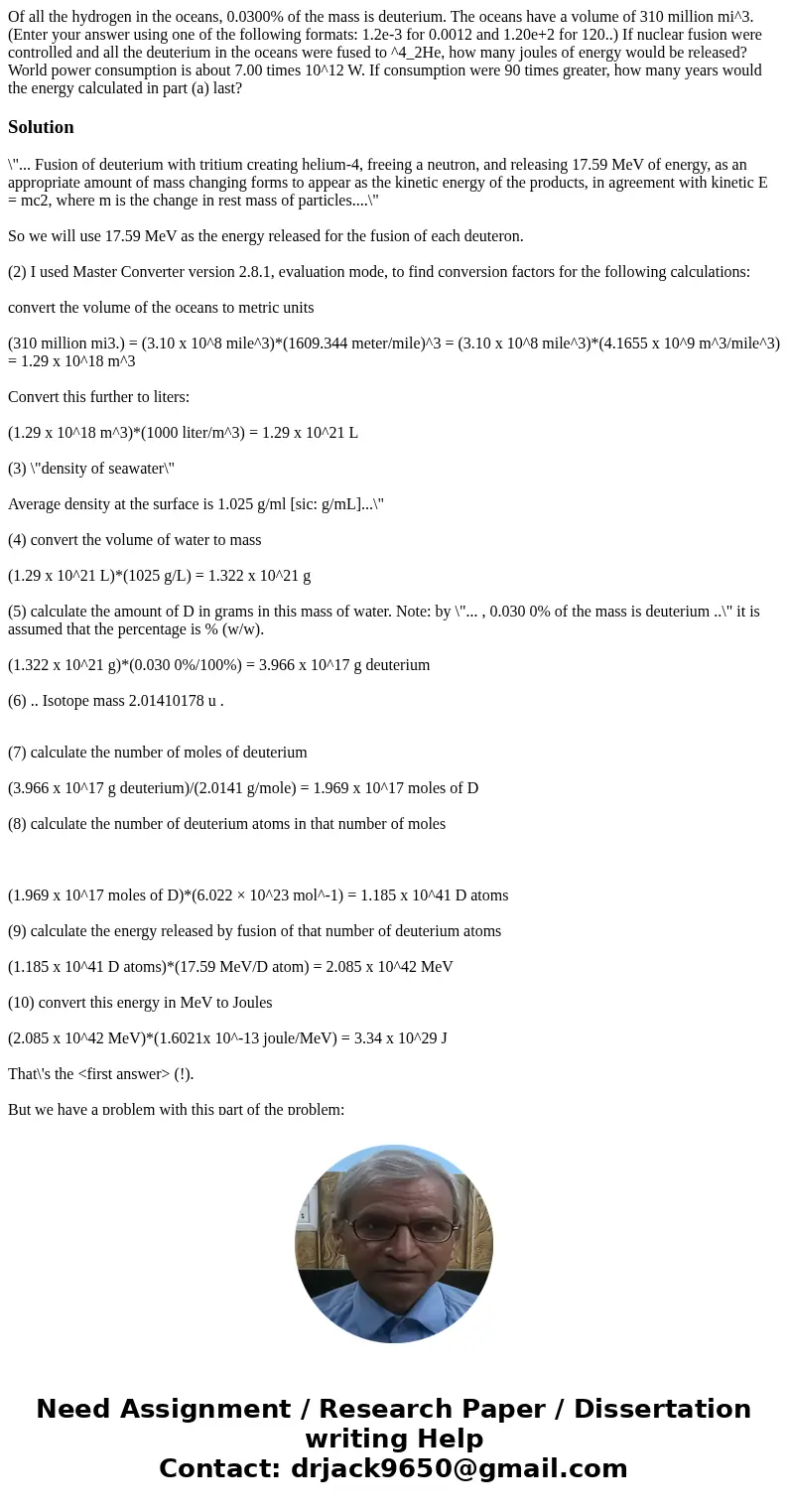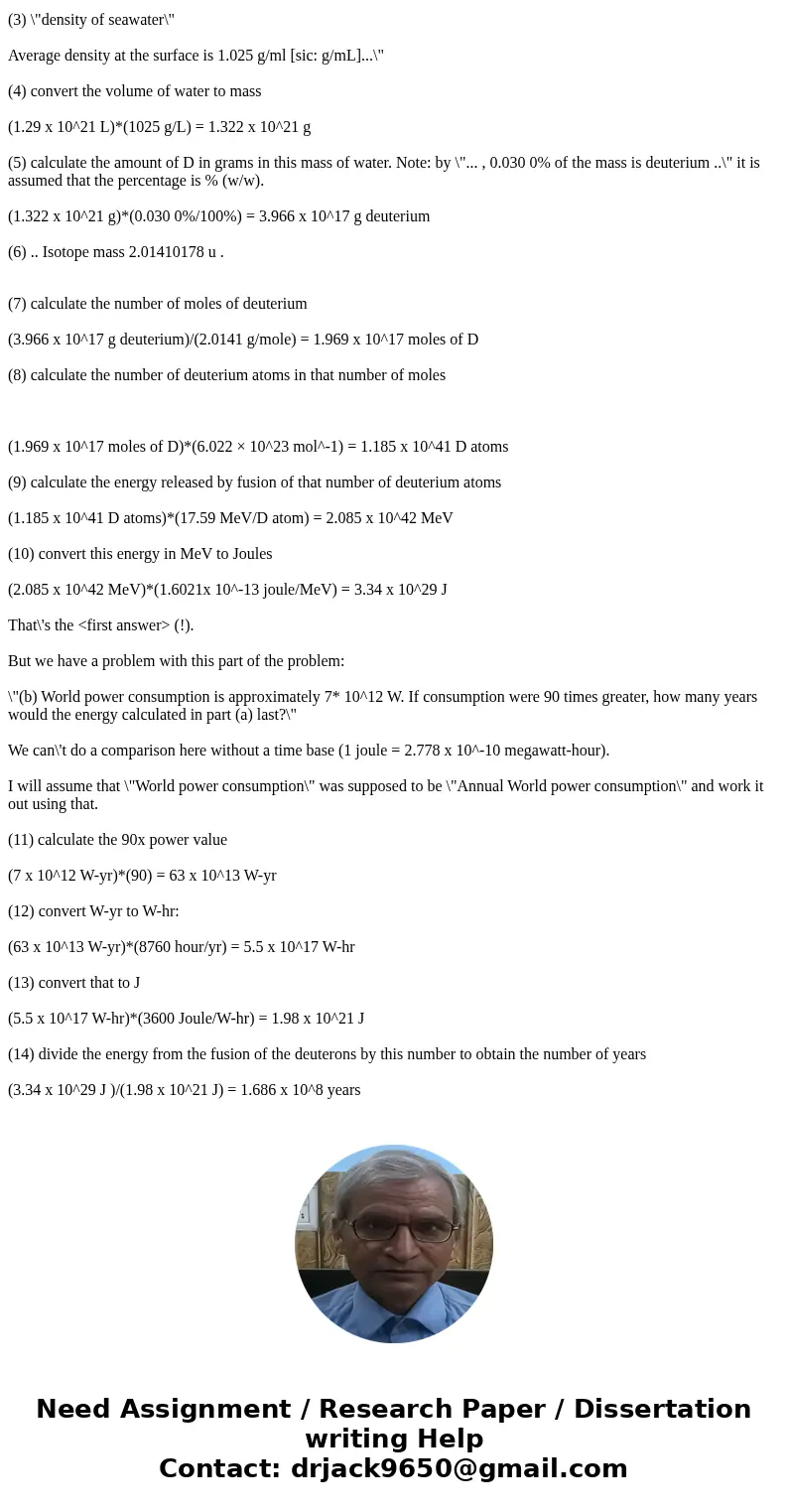Of all the hydrogen in the oceans 00300 of the mass is deute
Solution
\"... Fusion of deuterium with tritium creating helium-4, freeing a neutron, and releasing 17.59 MeV of energy, as an appropriate amount of mass changing forms to appear as the kinetic energy of the products, in agreement with kinetic E = mc2, where m is the change in rest mass of particles....\"
So we will use 17.59 MeV as the energy released for the fusion of each deuteron.
(2) I used Master Converter version 2.8.1, evaluation mode, to find conversion factors for the following calculations:
convert the volume of the oceans to metric units
(310 million mi3.) = (3.10 x 10^8 mile^3)*(1609.344 meter/mile)^3 = (3.10 x 10^8 mile^3)*(4.1655 x 10^9 m^3/mile^3) = 1.29 x 10^18 m^3
Convert this further to liters:
(1.29 x 10^18 m^3)*(1000 liter/m^3) = 1.29 x 10^21 L
(3) \"density of seawater\"
Average density at the surface is 1.025 g/ml [sic: g/mL]...\"
(4) convert the volume of water to mass
(1.29 x 10^21 L)*(1025 g/L) = 1.322 x 10^21 g
(5) calculate the amount of D in grams in this mass of water. Note: by \"... , 0.030 0% of the mass is deuterium ..\" it is assumed that the percentage is % (w/w).
(1.322 x 10^21 g)*(0.030 0%/100%) = 3.966 x 10^17 g deuterium
(6) .. Isotope mass 2.01410178 u .
(7) calculate the number of moles of deuterium
(3.966 x 10^17 g deuterium)/(2.0141 g/mole) = 1.969 x 10^17 moles of D
(8) calculate the number of deuterium atoms in that number of moles
(1.969 x 10^17 moles of D)*(6.022 × 10^23 mol^-1) = 1.185 x 10^41 D atoms
(9) calculate the energy released by fusion of that number of deuterium atoms
(1.185 x 10^41 D atoms)*(17.59 MeV/D atom) = 2.085 x 10^42 MeV
(10) convert this energy in MeV to Joules
(2.085 x 10^42 MeV)*(1.6021x 10^-13 joule/MeV) = 3.34 x 10^29 J
That\'s the <first answer> (!).
But we have a problem with this part of the problem:
\"(b) World power consumption is approximately 7* 10^12 W. If consumption were 90 times greater, how many years would the energy calculated in part (a) last?\"
We can\'t do a comparison here without a time base (1 joule = 2.778 x 10^-10 megawatt-hour).
I will assume that \"World power consumption\" was supposed to be \"Annual World power consumption\" and work it out using that.
(11) calculate the 90x power value
(7 x 10^12 W-yr)*(90) = 63 x 10^13 W-yr
(12) convert W-yr to W-hr:
(63 x 10^13 W-yr)*(8760 hour/yr) = 5.5 x 10^17 W-hr
(13) convert that to J
(5.5 x 10^17 W-hr)*(3600 Joule/W-hr) = 1.98 x 10^21 J
(14) divide the energy from the fusion of the deuterons by this number to obtain the number of years
(3.34 x 10^29 J )/(1.98 x 10^21 J) = 1.686 x 10^8 years


 Homework Sourse
Homework Sourse